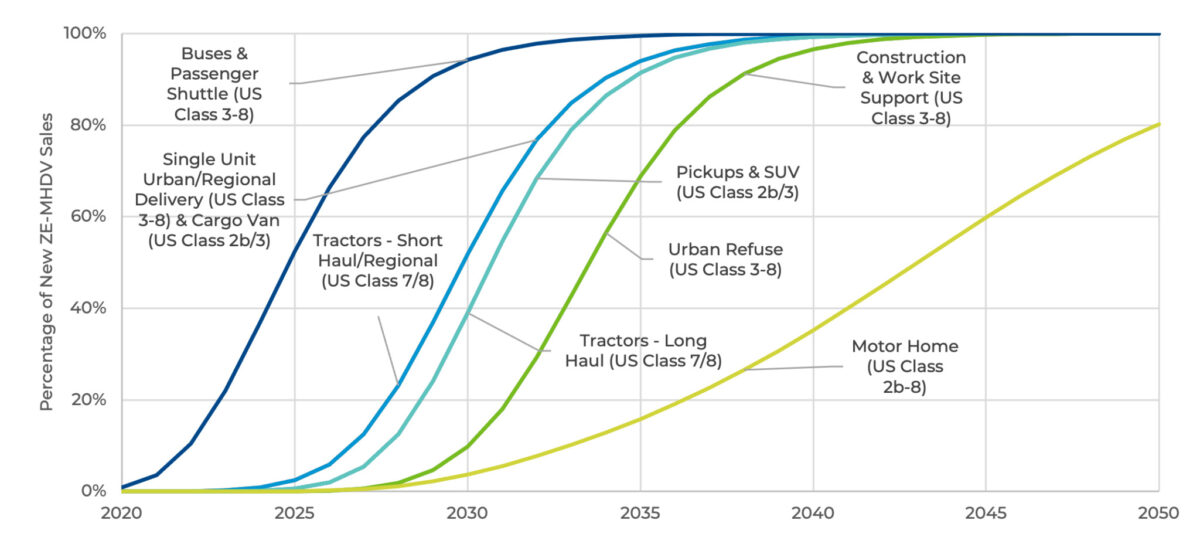As you might already know, at COP26 15 countries signed a global agreement on zero-emission medium- and heavy-duty vehicles (ZE-MHDVs) that for the first time aligned leading nations on a path towards 100% new ZE-MHDV sales by 2040, and an interim 30% target by 2030. What you might not know yet is all the technical work that happened behind the scenes to build a solid foundation for the ambitious yet feasible targets. While a full transition of new ZE-MHDV fleets by 2040 is needed to achieve net-zero carbon emissions by 2050 – a goal that many countries have already announced – how do we know these targets are feasible? This is the main takeaway from our most recent publication, which examines how fast we can scale up ZE-MHDV adoption taking into consideration technology readiness, supply scalability (how fast manufacturers can scale up production) and fleet demand (how likely fleets are to adopt a new technology). Results show early adoption for buses and passenger shuttles/vans, followed by single-unit trucks for urban and regional delivery and short/regional haul tractors, tailed closely by pickups/SUVs. These results reflect the timing for technology readiness of ZE technologies for different vehicle segments, and recognize that ZE technologies can be transferred across vehicle types as technologies evolve and costs decrease. Further along in the adoption timeline are more specialized vehicles like refuse and construction trucks, as well as mobile homes, which represent a relatively small, specialized share of MHDVs. We hope this analysis will strengthen confidence that such targets are indeed achievable.

Figure extracted from “Global Sales Targets for Zero-Emission Medium- and Heavy-duty Vehicles”
– Cristiano Façanha, Global Director, CALSTART/Drive to Zero
Program Updates
Zeroing in on ZETs
CALSTART released a new report that inventories Class 2b-8 zero-emission trucks (ZETs) in the United States. As of December 2021, over 163 customers have deployed 1,215 ZETs in their operations, and there are currently over 140,000 pending orders for commercial ZETs to be fulfilled. The report provides insight on ZET market trends as the industry prepares for an injection of federal funding for charging infrastructure, multiple states implement clean truck regulations, and California prepares to release an additional $873 million in purchase incentives for commercial vehicles and infrastructure. (LINK)
Global Sales Targets for Zero-Emission Medium- and Heavy-duty Vehicles
CALSTART also released a new white paper that establishes projections of global zero-emission medium- and heavy-duty vehicle (ZE-MHDV) sales targets through 2050 in alignment with the global Memorandum of Understanding (MOU) for trucks and buses launched at COP26 in Glasgow in 2021. This analysis uses CALSTART’s Global ZE-MHDV market projection target tool to estimate the adoption rate of on-road ZE-MHDVs across countries. (LINK)
ZETI Relaunch Webinar / Digital Dialogue / Event
On March 9 at 9am PT, Drive to Zero will relaunch its Zero-Emission Technology Inventory (ZETI) tool and unveil new data about model availability growth in the zero-emission truck and bus segment via our ZETI Analytics tool. Join us for a live demonstration of the new tool and digital dialogue with industry leaders. (LINK)
Pledge Partner Updates
The Drive to Zero pledge partner network continues to grow, and we are excited to welcome the following organizations that recently signed the Drive to Zero Pledge:
- Manufacturers: Volvo and Voltu Motor
The Drive to Zero pledge partner network now stands at over 135 partners working together to accelerate the market for ZECVs. Learn more about the Pledge on the Drive to Zero website.
News Updates
Support for electric trucks continues to accelerate, with increasing orders from fleets and significant investment from governments and the private sector. Volvo Trucks is expanding its footprint for electric trucks into Canada, with two dealerships in Quebec passing the training program to become Canada’s first Volvo Trucks-certified electric vehicle dealers. Down Under, the Australian Trucking Association (ATA) is now collaborating with Electric Vehicle Council (EVC) to identify policies to increase electric truck adoption by Australian fleets. Mack Trucks announced a new Vehicle-as-a-Service (VaaS) program to increase affordability of its LR Electric battery-electric truck, GM is now working with Lightning eMotors to get its Class 3 to 6 commercial vehicle platforms electrified, and Daimler, BlackRock, and NextEra are making a joint $650 million investment to deploy an electric trucking network across the United States. Adoption of electric buses by fleets has also gained momentum, aided by advances in technology and cost. Sydney and New York City both placed new electric bus orders, and Israel mandated that its bus operators can only purchase electric buses by 2026.
Support for both battery-electric and hydrogen fuel cell trucks continues to grow, as OEMs and fleets navigate the respective benefits and advantages of each technology. Despite the company’s work on two fuel cell projects, Navistar announced its support for battery-electric trucks as long-term solution for commercial trucking decarbonization. PACCAR is now working with ABB to provide charging solutions for PACCAR’s EV truck fleets across North America and Europe. To serve its heavy-duty drayage trucks, the Port of Long Beach is creating the largest electric truck charging network in the United States. The Department of Energy is backing advances in both battery-electric and hydrogen fuel cell systems, with an $8 billion investment in hydrogen initiatives and a plan for nearly $3 billion to be spent on increasing domestic production of advanced batteries. Finally, the International Council on Clean Transportation recently released a meta-study of purchase costs for zero-emission trucks, concluding that “electric propulsion systems for zero-emission tractor trucks make up roughly 85% to 90% of total truck costs, but this is expected to fall to 75% to 85% as battery pack and fuel cell system costs are estimated to drop by 50% and 65%, respectively, over the next decade.”
Please share new information, potential partners, and innovative practices to achieve our Drive to Zero goals at info@globaldrivetozero.org. Follow us on Twitter @TeamDrivetoZero. Please feel free to share this newsletter with others.
– Justin Slosky, Technical Writer, CALSTART
News Digest
 |
Events / Reports |
 |
Market
|
 |
Fleet Deployments |
 |
Manufacturers and Models: Trucks and Buses
|
 |
Government Policies
|
 |
Fuels & Infrastructure
|
 |
Batteries & Technology
|
 |
Environment
|
